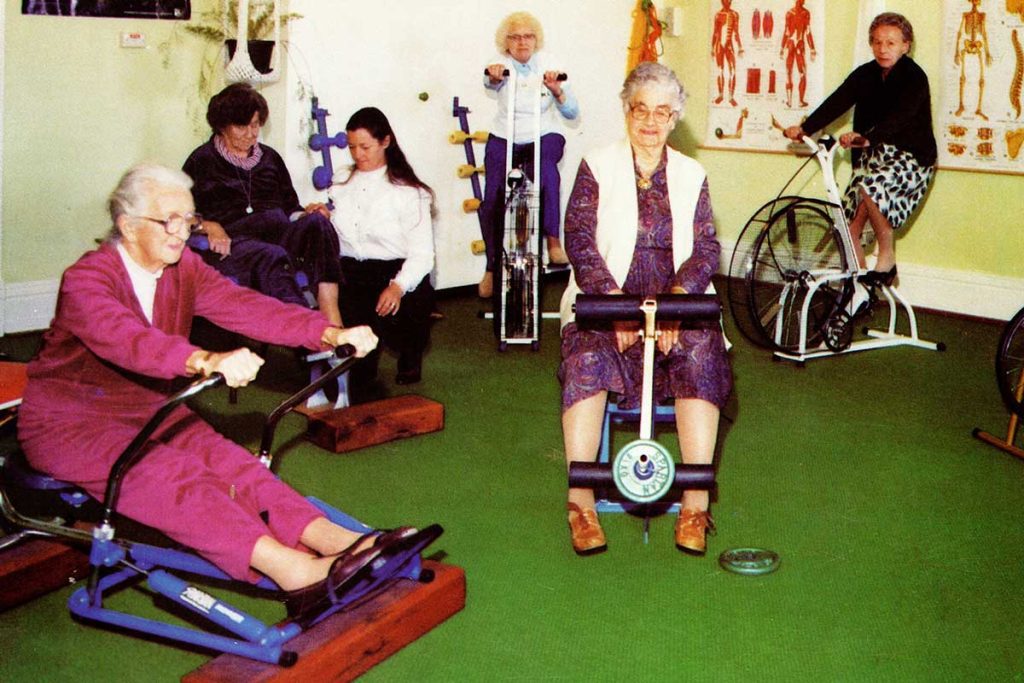Bringing home care home
Bronwyn Harding, who has worked at ACH Group since 1983, said: “By the 80s older people were saying loudly that they wanted to remain in their own homes instead of moving into residential care.”
At the time, Day Centres – funded by the Commonwealth Government – were available for those living at home to come in for a day and receive a range of services, a large proportion of which weren’t chosen by them. Aged Cottage Homes had Day Centres connected to Perry Park, Kapara and Milpara.
Mike Rungie said: “It was in the early 80s we were investigating the application of SRV theory in the support of people living in their own home, and the Federal Government was reviewing home care in Australia. Aged Cottage Homes sent its leaders overseas to look at the impacts of SRV theory in caring for people living in their own home. Now, one of those trips discovered a program in Wisconsin, it was so simple – but was radical at the time – as they allocated a budget to people who were living in their homes and they could choose their own services.”
On return, Aged Cottage Homes met with Commonwealth Government representatives, and they were interested in the program.
In 1984, leaders from America and the United Kingdom, the Commonwealth Government, and Aged Cottage Homes undertook a national training tour educating aged care providers on Community Options. It would become Australia’s first Commonwealth funded home care program.
ACH Group continued to be at the centre of innovation and change in Australia’s home care landscape. In 1995, it led the national Nursing Home Options trial, which converted 35 places at Milpara to community care and saw residents returning to live in the community. This was essentially the precursor to today’s Level 3 and 4 Home Care Packages.
In 2009, the Commonwealth announced that it was moving to Consumer Directed Care (CDC) in two years’ time. Mike Rungie said: “ACH Group immediately set up and funded its own CDC trial, an approach that put the consumer in control of how their government subsidy was spent, and we published the results nationally. We collaborated with the customers on what would make the biggest difference in their lives.”

Health
Throughout the 80s to the early 2000s, community health services were made available through Day Centres which were almost always linked to residential care homes.
“There was a movement for more services to be delivered in a community environment and the ‘Day Centres’ started to locate themselves at community locations, for example Milpara went to Montacute Road, Newton, and Kapara to Brighton Road, Glenelg,” Barbara Tainsh, an employee of ACH Group since the early 90s, said.
Innovation was again seen in ACH Group’s health offering in 2007 with it being one of the first aged care providers in South Australia to employ an Exercise Physiologist to specialise in exercise prescription and chronic disease management.
The prominence of older people seeking health services was influenced by the introduction of the Commonwealth Home Support Programme in 2015 which had a focus on customers seeking services in the community, coupled with the growing awareness by customers of the importance of staying physically active.
“A driving force around the expansion of the Health Studio 50+ locations is that people are wanting to stay healthy, active and mobile, and realising that exercise is a great way to help achieve this.
Our health service offering has increased, we provide a much wider range of services including wellness classes, exercise programs on state-of-the-art HUR gym equipment (some of the first in the state), allied health and massage – providing a holistic approach to achieving a customer’s best health,” Barbara said.

Social
Where activities were once provided through Day Centres for entertainment purposes, the social program at ACH Group has evolved significantly.
In 2019, work was undertaken to ensure that social experiences not only supported customers and residents to engage in a social setting and create connections, but that a range of unique programs would provide participants with opportunities to take on new roles, learn new skills and pursue interests and passions.
Examples of these unique programs include the Sing for Joy Choir, which has performed at Adelaide Fringe, art classes and golf lessons led by professionals in their fields. Partnering with reputable organisations to enhance social experiences has also featured heavily.



